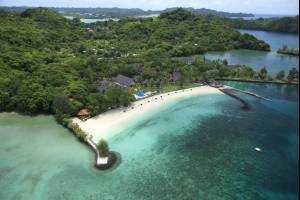The AirPano team, while shooting the most picturesque corners of the planet, does not forget about its amazing inhabitants. The heroes of our panoramas were penguins, bamboo and brown bears, sharks and other fish. In Cuba, we managed to swim next to a huge jellyfish, and this is a truly mesmerizing sight! So when I learned that there is a whole lake of jellyfish in Palau, I wanted to go there.
360° video, Jellyfish Bay, Raja Ampat, Indonesia
From that moment on, adventures began, turning into obstacles: as if some higher powers, having learned about my plans, arranged a game in which I was a figure on a chessboard. "One step forward - two steps back", and so on - throughout the entire planning of filming the jellyfish lake. But first things first.
The island nation of Palau is located in the Pacific Ocean, about 800 km from the Philippines and Indonesia. It is very far, but the dream of visiting it was shattered for another reason. While collecting information, I learned that the lake no longer exists. That is, the reservoir remained in its place, but its fragile ecology was destroyed by numerous tourists who used sunscreen while swimming, which turned out to be poisonous to jellyfish. To save the last representatives of nature, the lake was closed to visitors.

Well, it would seem that it is high time to give up on the idea - but it was not so! Quite by chance it turns out that there is also a jellyfish lake in Indonesia, and we are going to the Indonesian islands of Raja Ampat literally in two weeks. Filming a dream again begins to seem like a reality. True, no one knows where this lake is, and it is necessary to find out its coordinates in advance. The fact is that the Raja Ampat archipelago is not the most convenient place for traveling: communication between a thousand small islands is carried out only by boats, helicopters do not fly, there are no seaplanes. In neighboring West Papua, there are at least a hundred tribes that have had no contact with civilization, and in some places cannibalism is practiced.
Searches on the Internet yielded encouraging results: it was possible to find a scientific paper by Indonesian scientists who described three lakes of jellyfish, which, by an amazing coincidence, were located near the places where AirPano filming was planned.

But then something went wrong again. The boat we had booked for underwater filming in Raja Ampat burned down! Meanwhile, the departure is approaching, and we need to find a new vessel…
True, I learned about this trouble thanks to an incredible and happy coincidence: at the Moscow Dive Show, participants from Indonesia were watching a video of the fire at the very moment when I passed by their stand. Well, forewarned is forearmed. Our film crew found a new boat. And here we are in Indonesia.
But when we had time to go to the jellyfish lake (at least to one of the three!), it turned out to be impossible: inquiries showed that everyone who had been there had not seen jellyfish for a long time. Could it be that they were also killed by tourists, as happened in Palau? It’s good that we didn’t fly there specifically for this. But higher powers do not let me forget about my previous plans: in one of the hotels, the guide suddenly tells me about a place full of jellyfish. Technically, this is not a lake, but a small bay in the winding coastline of the island, but this does not make the encounter with sea creatures less interesting.

A small but not so important obstacle is the lack of information about the time of appearance of jellyfish: scientists wrote in the study that they are most likely to be seen at noon, and the guide insists that these animals do not like sunlight. We arrived at the bay in the afternoon and did not regret it. The water here is yellow-green, visibility is poor, and during the day it is an unremarkable place. But closer to the evening, jellyfish begin to rise from the depths, and it is worth seeing. There are a lot of jellyfish, they seem to be glued together in a huge ball that fills the entire water space.
Jellyfish are not the best company for diving. Although diving into a jellyfish "mess" does not pose a serious danger, touching sensitive parts of the body, such as the neck or lips, is quite painful.
This day can be called a reconnaissance one: I only took photos, and then after some time I returned there with colleagues - our task was to shoot 360° video.

If you follow this peculiar "chess game", it is already obvious that the victory went to our side. But the enemy still tried to make a few attacks. So, the captain decided to take us to "another bay of jellyfish"; the only thing that saved us was that I wrote down the coordinates of the right place in my phone.

So, a thousand coincidences and persistence - and as a result, a panoramic shot of a pond full of jellyfish took place!
Source: travel.ru













